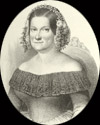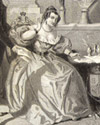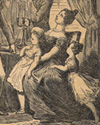19th Century´s militar history in the Basque Country
M CRISTINA OF BOURBON. (1806-1878)
 Daughter of King Francis I of the Two Sicilies, Maria Christina of Bourbon was born in Naples in 1806. She was the fourth wife of her uncle Ferdinand VII, to whom she finally gave offspring in the form of Isabel II in 1830. The proclamation of the Pragmatic Sanction that abolished the Salic law prohibiting women from ruling removed the Infante Don Carlos from his path to the throne and led to the outbreak of the First Carlist War upon the King's death.
Daughter of King Francis I of the Two Sicilies, Maria Christina of Bourbon was born in Naples in 1806. She was the fourth wife of her uncle Ferdinand VII, to whom she finally gave offspring in the form of Isabel II in 1830. The proclamation of the Pragmatic Sanction that abolished the Salic law prohibiting women from ruling removed the Infante Don Carlos from his path to the throne and led to the outbreak of the First Carlist War upon the King's death.
Before this and because of her husband's illness, in 1832, Maria Christina had assumed the functions of regent and granted an amnesty permitting some Liberals to return to Spain.
Upon the death of Ferdinand VII, Maria Christina became Queen Regent and received the support of the Liberals in her defence of her daughter’s rights to the throne, in the face of insurrection by the supporters of her brother-in-law, Don Carlos.
 She appointed the Moderate Liberal Martínez de la Rosa as leader of the government. In April 1834, he passed the Royal Statute, which marked the definitive transition from an absolute to a constitutional monarchy. The following year, in the wake of a revolutionary uprising, Maria Christina appointed the Progressive Mendizábal as the head of her government. Mendizábal developed a project for the disentailment of Church estates in order to raise funds to put an end to the Carlist war.
She appointed the Moderate Liberal Martínez de la Rosa as leader of the government. In April 1834, he passed the Royal Statute, which marked the definitive transition from an absolute to a constitutional monarchy. The following year, in the wake of a revolutionary uprising, Maria Christina appointed the Progressive Mendizábal as the head of her government. Mendizábal developed a project for the disentailment of Church estates in order to raise funds to put an end to the Carlist war.
 In August 1836, the sergeants of La Granja mutinied, forcing the Regent to promulgate the 1812 Constitution and paving the way for a new constitutional period that ended with the Progressive Constitution of 1837. At this time, Maria Christina was under pressure from the more extreme Liberals and began secret negotiations with Don Carlos, which ended with him travelling to the capital on the Royal Expedition. When the Carlists finally reached the gates of Madrid, the political scene had changed and the Moderates were in power. Maria Christina had changed her mind and abandoned her plan of negotiations with the Pretender.
In August 1836, the sergeants of La Granja mutinied, forcing the Regent to promulgate the 1812 Constitution and paving the way for a new constitutional period that ended with the Progressive Constitution of 1837. At this time, Maria Christina was under pressure from the more extreme Liberals and began secret negotiations with Don Carlos, which ended with him travelling to the capital on the Royal Expedition. When the Carlists finally reached the gates of Madrid, the political scene had changed and the Moderates were in power. Maria Christina had changed her mind and abandoned her plan of negotiations with the Pretender.
It was during this period that Maria Christina secretly married Fernando Muñoz, with whom she had seven children and lived during her years of exile.
In August 1839, Espartero and Maroto signed the Bergara Convention, which was a decisive step towards putting an end to the First Carlist War. The following year, the Queen Regent's direct confrontation with the Progressives forced her to renounce the regency and go into exile, leaving the power in the hands of Espartero. Throughout his regency, Maria Christina encouraged Moderate uprisings such as that of Diego de León in 1841, which failed despite the support of the Basque provincial governments. She returned to Spain after the fall of Espartero in 1843, coinciding with the proclamation of her daughter Isabel II's coming of age.
During the Moderate decade (1844-54), she had a powerful influence on politics and was despised by the Progressives. She was expelled from Spain after the uprising that put Espartero back in power in 1854. She never abandoned political intrigue, whether in Spain, on her return in 1856, or in exile, where she returned after the 1868 revolution.
She died in 1878 in Sainte Adresse, France.

